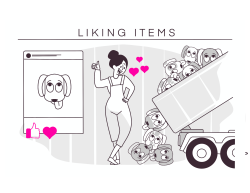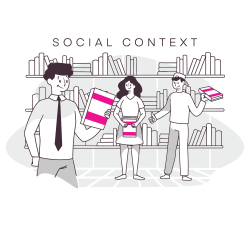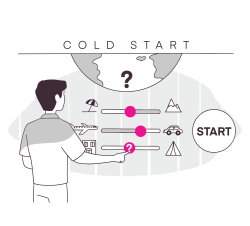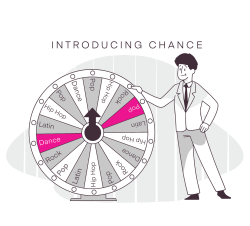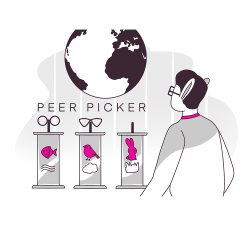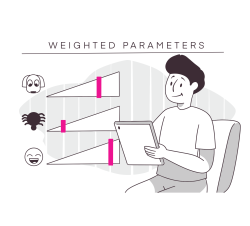
What are Algorithmic Affordances?
Algorithmic affordances allow a user to alter how an automated system generates an output based on data input. In this sense, algorithmic affordances characterize the range of explicit and implicit (hidden) interaction possibilities that enable the user to engage with and eventually control the algorithmic system directly and/or indirectly. Affordances are inherently context dependent [2]. The most crucial factors are the interface and its underlying design choices as well as an individual user’s understanding of a technology and her motivations. Concerning e.g., recommender systems, this may further include algorithmic awareness and an understanding of data [3]. The perceived usefulness and/or value of an output depends on the purpose of the automated system and often also on the richness of the available data. Providing users with controls to steer the inflow of data and weighing different parameters for the underlying model is not common in current algorithmic systems but also not entirely unheard of either. Several proposals have been made, as we elaborate in the next section.
[1] Ulrike Klinger and Jakob Svensson. 2018. The end of media logics? On algorithms and agency. New Media & Society 20, 12 (2018), 4653–4670.
[2] Nancy Ettlinger. 2018. Algorithmic affordances for productive resistance. Big Data & Society 5, 1 (2018), 2053951718771399.
[3] Leyla Dogruel, Dominique Facciorusso & Birgit Stark (2020) ‘I’m still the master of the machine.’ Internet users’ awareness of algorithmic decision-making and their perception of its effect on their autonomy, Information, Communication & Society, DOI: 10.1080/1369118X.2020.1863999
Why theses patterns?
Pioneered by Christopher Alexander (1979) design patterns are a common way to define a design language [4]. Design patterns are reusable solutions to common problems interaction design. A pattern library comprises of a set of interrelated solutions (a pattern language) for a larger problem area. It can be seen as partly prescriptive, partly generative theory ([5]. Using pattern libaries is a common approach in interaction design to harmonize an interaction language across different domains [6]. There were several considerations for constructing an algorithmic affordances pattern library. Our first consideration builds on the observation that the interaction language for algorithmic control was scattered across different domains, whereas in our view the interaction language could be defined in a domain independent way.
Second, while we noticed that algorithmic affordances were prevalent in diverse commercial systems, there seemed to be a disconnect between industry practice and academia. Proposals from academia found no uptake in practice, while patterns in commercial systems were insufficiently described and evaluated in academic literature. A pattern library could act as a boundary object: on the one hand, it should provide practitioners with useful practical information and concrete ideas for how to add interactivity to their algorithms. On the other hand, it should serve as a systematic overview of scientific research. More specifically, we intended to present solutions for algorithmic affordances in conjunction with the latest available evidence-based insights from academia for the effectiveness of different solutions. In this way, the pattern library aims for optimizing the knowledge transfer between academia and industry.
Finally, we also have an educational objective with the pattern library. Designers need to have a good sense of the available solutions. Offering a library may inspire young designers to expand their solution repertoire by looking at solutions they recognize from their own experience from a new angle and by being confronted with novel solutions they were previously unaware of [7].
[4] Christopher Alexander. 1979. The timeless way of building. New York: Oxford university press.
[5] Koen van Turnhout, Marjolein Jacobs, Miriam Losse, Thea van der Geest and René Bakker. 2019. A Practical Take on Theory in HCI. Available from: http://bit.ly/TheoryHCI
[6] Berkeley J Dietvorst, Joseph P Simmons, and Cade Massey. 2018. Overcoming algorithm aversion: People will use imperfect algorithms if they can (even slightly) modify them. Management Science 64, 3 (2018), 1155–1170
[7] Koen van Turnhout, Aletta Smits (2021). Solution Repertoire. In DS 110: Proceedings of the 23rd International Conference on Engineering and Product Design Education (E&PDE 2021), VIA Design, VIA University in Herning, Denmark. 9th-10th September 2021. https:/doi.org/10.35199/EPDE.2021.41

Some examples of use
Above example are images used to temporary fill the space. These examples are not used as algorithmic affordances. Please be patient to see our library admins fills theses gabs as soon as possible.
Pattern Categories
We considered something to be a pattern candidate when the control occurred in two sources, for example both an academic proposal and a commercial system, and when it was sufficiently different from other controls. This led to 15 initial pattern candidates, which were subsequently clustered into four categories, signifying a fundamentally different solution direction found in the list below:


